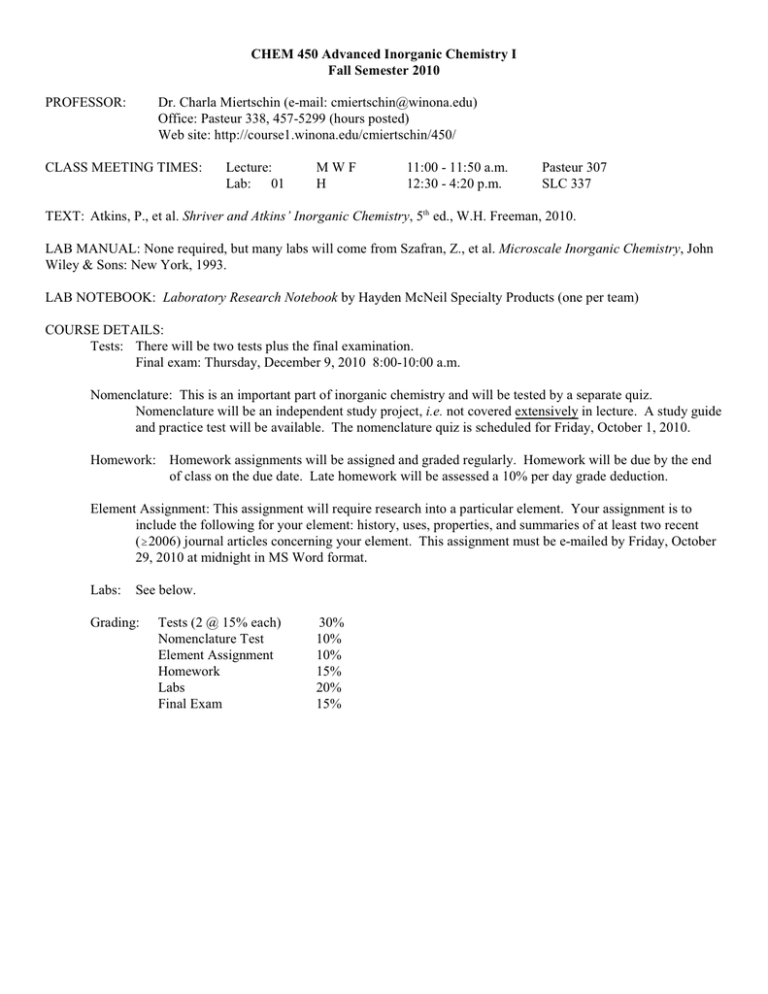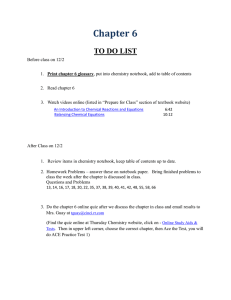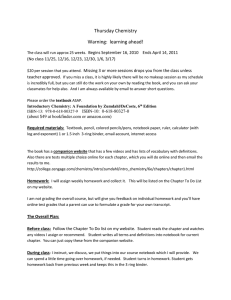CHEM 450 Advanced Inorganic Chemistry I Fall Semester 2010 PROFESSOR:
advertisement

CHEM 450 Advanced Inorganic Chemistry I Fall Semester 2010 PROFESSOR: Dr. Charla Miertschin (e-mail: cmiertschin@winona.edu) Office: Pasteur 338, 457-5299 (hours posted) Web site: http://course1.winona.edu/cmiertschin/450/ CLASS MEETING TIMES: Lecture: Lab: 01 MWF H 11:00 - 11:50 a.m. 12:30 - 4:20 p.m. Pasteur 307 SLC 337 TEXT: Atkins, P., et al. Shriver and Atkins’ Inorganic Chemistry, 5th ed., W.H. Freeman, 2010. LAB MANUAL: None required, but many labs will come from Szafran, Z., et al. Microscale Inorganic Chemistry, John Wiley & Sons: New York, 1993. LAB NOTEBOOK: Laboratory Research Notebook by Hayden McNeil Specialty Products (one per team) COURSE DETAILS: Tests: There will be two tests plus the final examination. Final exam: Thursday, December 9, 2010 8:00-10:00 a.m. Nomenclature: This is an important part of inorganic chemistry and will be tested by a separate quiz. Nomenclature will be an independent study project, i.e. not covered extensively in lecture. A study guide and practice test will be available. The nomenclature quiz is scheduled for Friday, October 1, 2010. Homework: Homework assignments will be assigned and graded regularly. Homework will be due by the end of class on the due date. Late homework will be assessed a 10% per day grade deduction. Element Assignment: This assignment will require research into a particular element. Your assignment is to include the following for your element: history, uses, properties, and summaries of at least two recent ($2006) journal articles concerning your element. This assignment must be e-mailed by Friday, October 29, 2010 at midnight in MS Word format. Labs: See below. Grading: Tests (2 @ 15% each) Nomenclature Test Element Assignment Homework Labs Final Exam 30% 10% 10% 15% 20% 15% 2 CHEM 450 Tentative Course Outline Chapter & Title Topics 1. Atomic Structure 9. Periodic Trends Atomic theory, e¯ configuration, periodic trends 2. Molecular Structure and Bonding (2.1-2.6, 2.13-2.16) Lewis theory, VSEPR, valence bond theory; structure and bond properties Coordination Chemistry 7. An Introduction to Coordination Compounds 19. The d-Block Elements History, definition, nomenclature, geometry, chirality; d-block element and compound properties 20. d-Metal Complexes: Electronic Structure and Properties Crystal field and ligand-field theories; electronic spectra; magnetic properties 6. Molecular Symmetry Symmetry operations, elements, and point groups; character tables; applications of symmetry 2. Molecular Structure and Bonding (2.7-2.12) Homonuclear and heteronuclear diatomic molecules, small polyatomic molecules, octahedral and tetrahedral coordination compounds Possible Lab Experiments Silicone Polymers: Preparation of Bouncing Putty Werner’s Notion – Cobalt Ammine Coordination Compounds Synthesis and Magnetic Properties of Metal Acetylacetonates Determination of Äo in Cr(III) Complexes Synthesis of Metal Nitrosyl Complexes Metal Complexes of Dimethyl Sulfoxide Molybdenum Mesitylene Compound Determination of Magnetic Moments in Metal-Metal Bonded Complexes Multiply Bonded Species: Preparation of Tetrabutylammonium Octachlorodirhenate(III) 3 Advanced Inorganic Chemistry Lab General lab requirements: 1. Safety goggles, long pants, and no open-toed shoes are mandatory in the laboratory. No lab work will be allowed without them. All labs must be performed at assigned times and no work will be done alone. 2. Lab reports will generally be due on Friday, one week after the completion of the experimental portion of the lab. 3. Lab teams will keep one notebook and complete one team report. Do not plagiarize the handouts or other sources – rephrase in your own words or cite. Watch spelling and grammar. 4. The Hayden McNeil Student Lab Notebook is required. You do not need to purchase a new notebook for this lab. The carbon copies will be submitted as part of the report. Lab Notebook Format A major portion of the lab grade will depend upon your ability to maintain a detailed, complete, accurate, and legible laboratory notebook. If you pursue a technical career, whether in government, industry, medicine or academia, a good research notebook is critical. You may be asked to verify data recorded months or even years later. Write your name on the outside of the notebook, please. Record your data in INK, using different colors for emphasis, if desired. Write all records directly into the notebook. Do not use separate scratch sheets for recording observations, data, etc. Permanently affix all spectra and computer-generated data sheets to the notebook in their appropriate places. Fill in the appropriate information at the top of each notebook page. When necessary, abbreviate the experiment title to fit into the block. For subsequent pages, write "Exp. # 99/cont." in the respective blocks. Follow the format below when writing your reports. Items 1-5 are to be written directly in the notebook. Items 6-8 should be word-processed and attached to the copies 1. Write the full title of the experiment. 2. Record the source of the experimental procedure. (e.g. Szafran, Experiment # 99, p. 999) 3. State the purpose(s) of the experiment briefly, including general reactions and equations. Draw the structures of the major reactants and products. Most labs will consist of a synthesis portion and a characterization portion. Include both in this section. In other words, describe what will be done, by what methods the data will be obtained, and how the results will be evaluated. Since this will be written before the lab, use future tense. 4. Prepare a Table of Reactants and Products. Include the name of each reagent, its molar mass, mass or volume to be used, moles (mmoles) to be used, and pertinent physical properties (m.p., b.p., density, toxicity, flammability). Also, for nonstandard lab chemicals, list the source (e.g. Strem, Sigma, Fisher). Include the theoretical yield for the major product(s). Don't forget to go back and fill in the experimental yield for the product! 5. Experimental Details. Describe the experimental procedure in detail in the order in which you actually performed the steps and with the actual amounts used. Include diagrams and sketches to describe unfamiliar equipment and glassware setups. Include the manufacturer and model number all major equipment used. Any and all observations made during the experiment should be included here, particularly of the product. If spectra or other analyses were obtained, describe and attach spectra or data. Since this is a record of what you actually did and observed, it should be written in past tense and, preferably, in passive voice. All lab team members should sign at the bottom of the last page of the experimental section. 4 6. Results*. Tables, charts, figures, reaction schemes, etc. should be used to summarize data and present the results clearly and concisely. Include calculations (may be hand-written in the notebook). For synthesis experiments always calculate percent yield(s) and give the reactant(s) on which you based your calculation. 7. Conclusion/Summary*. Give an overview of the lab. Summarize the main features of the lab - the objectives, the analysis of the data, the results, the interpretation of the results and the conclusions reached. Address topics such as what was learned, advantages or disadvantages of the method used, accuracy, precision, convenience, modifications for improvement, sources of error, and anything else you think would be appropriate. Were your results as expected? If so, discuss your confidence in the results. If not, discuss why not. 8. If any post-lab questions* were assigned, include them after the conclusion or as part of the conclusion as appropriate. * These sections are to be word processed. As such, attention to detail should be exercised. Use subscripts, superscripts, and degree signs appropriately -- these are easily accessible in all modern word processors. Please also include a title page for the report consisting of the experiment's title, team member's names, course number and section, and the date submitted. Embellishments are not required, but are pleasant to receive. Citation Examples Journal Articles: Hoak, J. S.; Swaney, D. L.; Wolfe, B. J. Inorg. Chem. 2003, 38, 1345. Authors (last name, initials), title of journal (in italics), year of publication (boldface), volume number (in italics), page number(s). Books: without editors: Tong, M.-Y.; Gander, D. C.; Advanced Inorganic Chemistry; Winona Press: Winona, MN, 2004; pp 1 - 57. with editor(s): Forensic Inorganic Chemistry; Goldstrand, S. L., Ed.; University of Minnesota Publishers: Minneapolis, 2004; Chapter 5. Authors (last name, initials), title of the book (in italics); edition (if other than first), publisher: city (and state, if applicable) of publication, year of publication; page number(s) or chapter number(s). Web sites: Kautz, N. A.; Knauer, R. M.; Morin, T. J., Symmetry in Inorganic Chemistry, http://studentwebs.winona.edu/chem450/symmetry (accessed August 2004) Author (if any), Title of site. URL (accessed date), other identifying information. Notes: Use the title found on the electronic site itself; add the words "Home Page", "database", or other term for clarification when needed. If the URL does not fit on one line, it can be broken, but only according to the following guidelines: • Break after an ampersand, a slash, or a period, but keep two slashes together. • Do not add a hyphen to the end of the line. • Do not break after a hyphen to avoid confusion as to the hyphen's purpose. For more information, see The ACS Style Guide: A Manual for Authors and Editors, 2nd ed.; Dodd, J. S., Ed.; American Chemical Society: Washington, DC, 1997.






